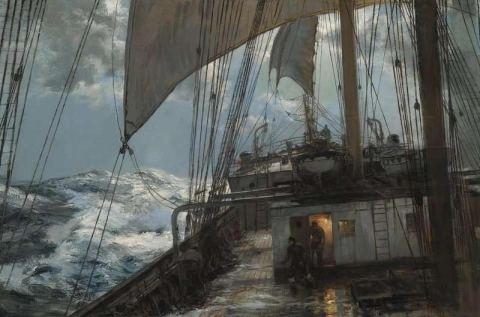Hand-painted painting reproductions - Movements - Maritime Art Movement
Welcome to the world of the Maritime Art Movement art movement!
At POD, we are passionate about reproducing high-quality oil paintings. We use a meticulous technique and artisanal know-how to create works of art that will take you on a mental journey.Imagine owning a museum-worthy piece of art, created by the greatest artists in history and reproduced by passionate and experienced painters. At POD, we offer you the opportunity to make that dream a reality. We reproduce the works of art of your favorite painters from the Maritime Art Movement art movement in the smallest details, so that you can enjoy them in your own home.
Our reproductions are made by experienced artists who use the best materials and techniques. We are committed to providing you with works of art of the highest quality, which will bring joy and inspiration to your family for generations to come.
Movement definition
The maritime art movement is a genre that focuses on the sea, ships, and naval scenes. This genre has a rich and storied history, reflecting humanity's enduring fascination with the ocean and its pivotal role in exploration, trade, and warfare. Maritime art can encompass a wide range of styles, from realistic and detailed portrayals to more abstract and expressive works. This genre has evolved over centuries, with contributions from many renowned artists who have captured the beauty, power, and mystery of the sea.Historical Background
Maritime art dates back to ancient times, with early depictions found in the art of civilizations such as the Egyptians, Greeks, and Romans. These early works often featured ships and naval battles, highlighting the importance of maritime activity in their cultures. However, it wasn't until the Age of Exploration in the 15th and 16th centuries that maritime art began to flourish as a distinct genre. The great voyages of discovery by explorers such as Christopher Columbus, Vasco da Gama, and Ferdinand Magellan inspired artists to depict the new and exotic lands and the ships that made these journeys possible.
The Golden Age of Maritime Art
The 17th century, often referred to as the Golden Age of Maritime Art, saw significant developments in this genre, particularly in the Netherlands. Dutch artists, influenced by their nation's seafaring prowess and trade dominance, produced a wealth of maritime paintings. Willem van de Velde the Elder and his son Willem van de Velde the Younger were among the most famous Dutch maritime artists. Their detailed and accurate depictions of ships and naval battles set new standards for the genre. The Van de Veldes were known for their ability to capture the intricacies of ship design and the drama of naval engagements, contributing significantly to the development of maritime art.
The 18th and 19th Centuries
The 18th century saw the continuation of maritime art's popularity, with artists such as Claude-Joseph Vernet in France producing grand seascapes that combined elements of Romanticism with meticulous detail. Vernet's works often featured dramatic skies and turbulent seas, emphasizing the sublime power of nature.
The 19th century brought about a diversification in styles and approaches within the maritime art genre. The Romantic movement, with its emphasis on emotion and the sublime, influenced artists like J.M.W. Turner. Turner's maritime paintings, such as "The Fighting Temeraire," are renowned for their atmospheric effects and dramatic use of light and color. His works captured the awe-inspiring and often tumultuous relationship between man and the sea.
The 20th Century and Beyond
The 20th century saw the continued evolution of maritime art, with artists exploring new techniques and perspectives. Montague Dawson, one of the most famous maritime artists of the 20th century, is known for his highly detailed and dynamic portrayals of ships and naval battles. Dawson's works, such as "The Battle of Trafalgar" and "Clipper Ships Racing," are celebrated for their historical accuracy and the sense of movement and drama they convey. His meticulous attention to detail and ability to capture the spirit of maritime adventure have made his paintings highly sought after by collectors.
In addition to Dawson, other notable maritime artists of the 20th century include Thomas M. Hoyne and John Stobart. Hoyne, an American artist, is known for his realistic depictions of historic sailing ships, while Stobart, also an American, has gained fame for his vibrant and detailed harbor scenes.
Themes and Techniques
Maritime art encompasses a wide range of themes, including ship portraits, naval battles, seascapes, and harbor scenes. Ship portraits, which focus on detailed and accurate depictions of individual vessels, have been a staple of the genre. These works often celebrate the craftsmanship and design of ships, showcasing their beauty and complexity.
Naval battle paintings capture the drama and intensity of maritime warfare. Artists like the Van de Veldes, Vernet, and Dawson excelled in depicting these scenes, conveying the chaos and heroism of naval engagements. These works often served as historical records, documenting significant battles and the ships involved.
Seascapes, another common theme in maritime art, focus on the natural beauty and power of the sea. Artists like Turner and Vernet used their mastery of light and color to create atmospheric and evocative scenes, capturing the ever-changing moods of the ocean.
Harbor scenes, featuring bustling ports and coastal towns, highlight the economic and social importance of maritime activity. These works often depict the daily life of sailors, fishermen, and dockworkers, providing a glimpse into the world of maritime commerce and trade.
Conclusion
The maritime art movement has a rich history that spans centuries and includes contributions from many renowned artists. From the detailed ship portraits of the Dutch Golden Age to the dramatic seascapes of the Romantic period and the historically accurate naval battles of the 20th century, maritime art continues to captivate audiences with its celebration of the sea and its significance in human history. Artists like the Van de Veldes, Vernet, Turner, and Dawson have left a lasting legacy, inspiring future generations to explore and appreciate the beauty and power of the ocean through art.





